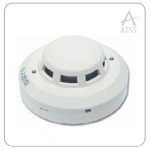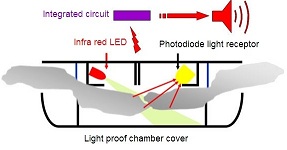SECURITY SYSTEMS SOLUTIONS
-
 Access Control
Access Control
-
 Asset Tracking
Asset Tracking
-
 Automatic Door
Automatic Door
-
 Baggage Scanner
Baggage Scanner
-
 Bell Timer
Bell Timer
-
 Boom Barrier
Boom Barrier
-
 BMS
BMS
-
 Burglar Alarm
Burglar Alarm
-
 Canteen Management
Canteen Management
-
 CCTV ANPR
CCTV ANPR
-
 CCTV People Counting
CCTV People Counting
-
 CCTV Surveillance
CCTV Surveillance
-
 CCTV Video Analytics
CCTV Video Analytics
-
 Central Vacuum Cleaner
Central Vacuum Cleaner
-
 DFMD
DFMD
-
 Electric Fence
Electric Fence
-
 EAS
EAS
-
 Fire Alarm
Fire Alarm
-
 Fire Hydrant
Fire Hydrant
-
 Fire Suppression
Fire Suppression
-
 Flap Barrier
Flap Barrier
-
 Garage Door
Garage Door
-
 Gas Detector
Gas Detector
-
 Gate Automation
Gate Automation
-
 GSM Communicator
GSM Communicator
-
 Guard Monitoring
Guard Monitoring
-
 HHMD
HHMD
-
 Home Automation
Home Automation
-
 Home Theatre
Home Theatre
-
 Hotel Lock
Hotel Lock
-
 ID Cards
ID Cards
-
 Lighting Automation
Lighting Automation
-
 Network & Communication
Network & Communication
-
 Nurse Calling System
Nurse Calling System
-
 Occupancy Sensor
Occupancy Sensor
-
 PA Systems
PA Systems
-
 Payroll
Payroll
-
 Road Blocker
Road Blocker
-
 Smart Lock
Smart Lock
-
 Time Attendance
Time Attendance
-
 Tripod Turnstile
Tripod Turnstile
-
 UVSS
UVSS
-
 Vehicle Tracking
Vehicle Tracking
-
 Video Door Phone
Video Door Phone
-
 Parking Management System
Parking Management System
-
 Visitor Management
Visitor Management
-
 Wireless Communication
Wireless Communication
Smoke Detector
How Does Optical Smoke Detector Work?
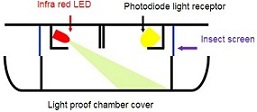
Smoke Detector – An optical smoke alarm (also called photo-electric smoke alarm) works using the light scatter principle,. The alarm contains a pulsed Infra red LED which pulses a beam of light into the sensor chamber every 10 seconds to check for smoke particles.
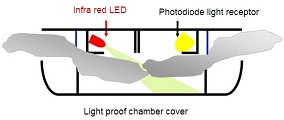
When a fire breaks out smoke will enter the optical chamber through the opening vents. Smoke alarms from quality manufacturers have the chamber protected with insect screens to stop bugs entering and causing false alarms.
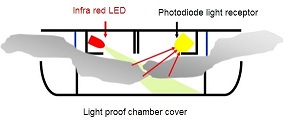
As the smoke enters the optical chamber, its particles cause the Infra red light to be scattered onto the photodiode light receptor.
Once the scattered light hits the photodiode light receptor a signal is sent to the integrated circuit which causes the alarm to sound alerting the occupants to the fire. An optical smoke alarm uses the principle of light sensors to identify the smoke and hence, detect fire. It consists of LED lights (light emitting diode), a lens and a photodiode.
Let’s know how light helps to detect a fire. A light emitting diode is a semiconductor device that operates on the principle of a diode. When the diode is forward biased, recombination of holes and electrons take place, thereby releasing energy in the form of light. In normal conditions (when there is no fire or smoke), light from the light emitting diode passes the detector in a straight line and so the alarm is not triggered.
A lens is provided in the optical smoke alarm device to direct the light source in the form of a light beam. In the events of a smoke, the smoke particles fill the smoke alarm and due to the presence of the smoke particles, the light beam gets deflected from the straight line path. The deflected light beam strikes the photoelectric sensors (photodiodes) and thus the alarm is triggered.
You must be thinking what is a photodiode? Well, a photodiode is another form of diode that become active when a light beam (photons) falls on it. These alarms are also called photoelectric alarms.
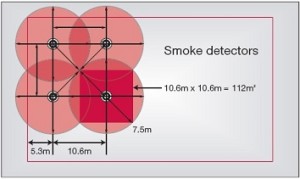
When mounted on a flat ceiling, smoke detection devices have an individual coverage of 7.5m radius. However these radii must overlap to ensure there are no “blind spots”. Therefore individual coverage can be represented by a square measuring 10.6 X 10.6m giving an actual coverage area of 112 m² per device.
Related
SECURITY SYSTEMS SOLUTIONS
-
 Access Control
Access Control
-
 Asset Tracking
Asset Tracking
-
 Automatic Door
Automatic Door
-
 Baggage Scanner
Baggage Scanner
-
 Bell Timer
Bell Timer
-
 Boom Barrier
Boom Barrier
-
 BMS
BMS
-
 Burglar Alarm
Burglar Alarm
-
 Canteen Management
Canteen Management
-
 CCTV ANPR
CCTV ANPR
-
 CCTV People Counting
CCTV People Counting
-
 CCTV Surveillance
CCTV Surveillance
-
 CCTV Video Analytics
CCTV Video Analytics
-
 Central Vacuum Cleaner
Central Vacuum Cleaner
-
 DFMD
DFMD
-
 Electric Fence
Electric Fence
-
 EAS
EAS
-
 Fire Alarm
Fire Alarm
-
 Fire Hydrant
Fire Hydrant
-
 Fire Suppression
Fire Suppression
-
 Flap Barrier
Flap Barrier
-
 Garage Door
Garage Door
-
 Gas Detector
Gas Detector
-
 Gate Automation
Gate Automation
-
 GSM Communicator
GSM Communicator
-
 Guard Monitoring
Guard Monitoring
-
 HHMD
HHMD
-
 Home Automation
Home Automation
-
 Home Theatre
Home Theatre
-
 Hotel Lock
Hotel Lock
-
 ID Cards
ID Cards
-
 Lighting Automation
Lighting Automation
-
 Network & Communication
Network & Communication
-
 Nurse Calling System
Nurse Calling System
-
 Occupancy Sensor
Occupancy Sensor
-
 PA Systems
PA Systems
-
 Payroll
Payroll
-
 Road Blocker
Road Blocker
-
 Smart Lock
Smart Lock
-
 Time Attendance
Time Attendance
-
 Tripod Turnstile
Tripod Turnstile
-
 UVSS
UVSS
-
 Vehicle Tracking
Vehicle Tracking
-
 Video Door Phone
Video Door Phone
-
 Parking Management System
Parking Management System
-
 Visitor Management
Visitor Management
-
 Wireless Communication
Wireless Communication


